The hike to Ashton Trail was difficult. Not only were the slopes steep but they were extremely slippery from yesterday's rain. I had many slips and some minor falls but that made the hike all the more thrilling. I was catching branches or thin trunks to prevent myself from slipping and was grateful for the ropes that were strung between trees along steep slopes. By about a quarter way, the soles of my shoes started giving way so I had to walk with high steps so as not to get the chattering soles caught in the fallen branches or roots of trees. By about the last quarter of the hike, my soles were almost coming off! A colleague suggested that I pulled them off my shoes, which I did. At one point, I was hurling both the soles down slopes because I required both my arms to hang on to ropes or trees. We finally found some big leaves and vines to wrap my mud-caked soles. That way, I could place them in my backpack without smearing mud all over the inside of my bag.
What's most fascinating at this point of our hike is the agarwood (native name: gaharu). This is the wood found at the heart of dying Aquilaria trees that had been attacked by infection. The infection excites the tree to produce resin. Not all types of Aquilaria trees produce agarwood and those that can, can also do so if the tree is infected by a type of mold. Due to its rarity, agarwood is very expensive. The resin extracts from agarwood are used to make perfumes that can last very long and these perfumes are highly cost. The agarwood in our neighbouring countries have already been depleted and with a high demand and high fetching price, agarwood has attracted pouchers from these countries. Evidence of their presence are marked by carvings on the tree trunk, a territorial code amongst pouchers.
Word has it that research on artificially creating agarwood has developed and the technique has been patented. It's rather disconcerting that people are worried about the depletion of agarwood rather than of Aquilaria trees capable of doing such fascinating thing. Seriously, the world does not need another Looten Plunder (character from Captain Planet and the Planeteers)! Do check out Brunei Agarwood on sale in EBay!! They are selling 11 grams for US$109.99!! Also check out more agarwood on sale here. Blue Brunei is a perfume oil made from Brunei's agarwood and they are selling $329.95 for 3 grams on this website!
Unlike unique Aquilaria trees, there were other several trees that secrete substances which hardened to become resin. The resin extracts are caked around the tree trunks, some are whitish in colour while some yellowish or look like ordinary rocks. Where the fluid substance continuously drips, a growing lump of resin forms. And, what do you know? Amber stones actually come from resins. They are of a fossilised form. So, if the substance happened to drown some ant or spider, you will get them in amber stones after millions of years!
The resin is aromatic when burned. Our guide demonstrated and we took in a waft of incensed air from the burning resin. This is the common use of resin amongst the natives in Temburong though it is claimed to have medicinal attributes as well.

Ahh.. nothing but trees
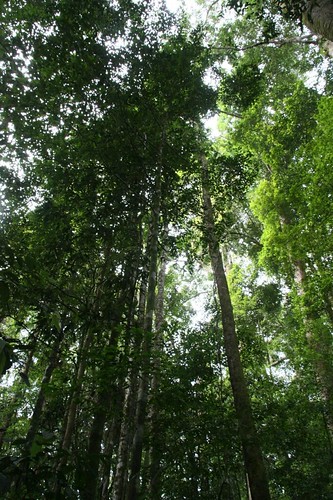
Yellow resin accumulated on a tree trunk
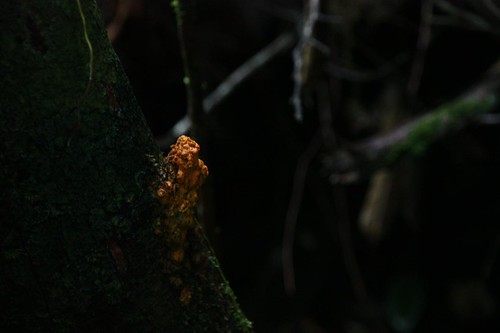
Fresh whitish resin formation around a tree trunk
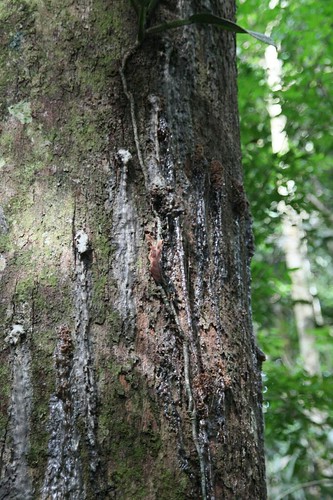
Aromatic when resin is burned
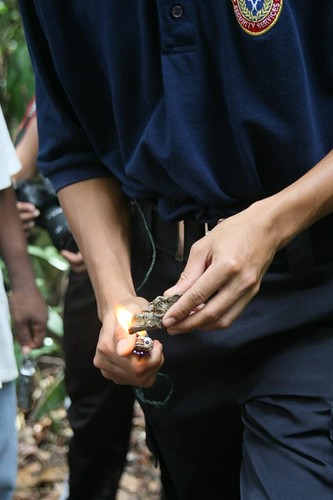
Quartz stones along the trail
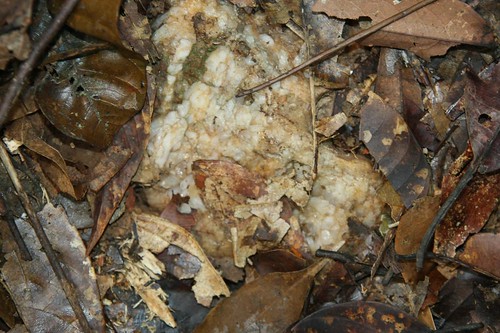
Graffiti on trees though similar form of marking is used by pouchers to mark "their" trees
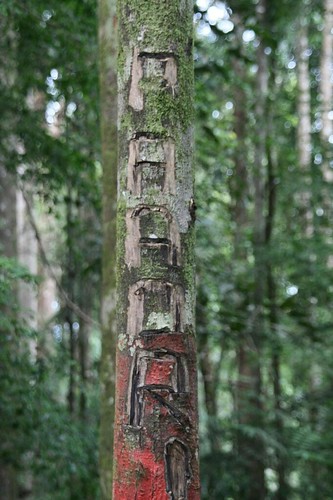
Some collected resin specimens

My wrapped-up shoe soles
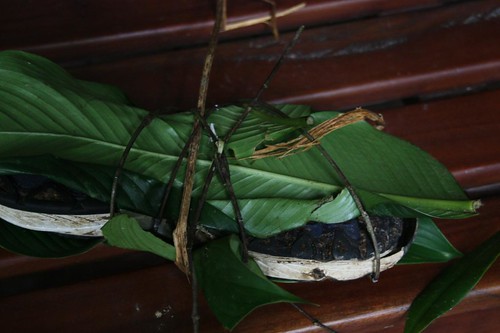
==============================================
Wonders of Belalong Rainforest
The Borneo Bulletin 18/10/2009
By NYL
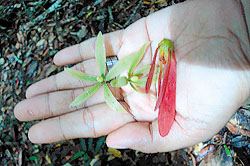
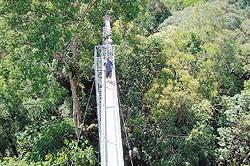

Fifteen Physics lecturers and students of UBD got a taste of nature over the weekend when they totally immersed themselves in a Belalong rainforest experience in Temburong.
The excursion included a stay at Universiti Brunei Darussalam Kuala Belalong Field Studies Centre (KBFSC) in Batu Apoi Forest Reserve and a visit to the Ulu Temburong National Park.
It gave the visitors ample opportunity to gain knowledge about the natural environment and a deeper understanding of the ecology of the Belalong rainforest.
The National Park tropical rainforest is one of the most complex and rich ecosystems in the world.
This lowland dipterocarp forest thrives with its diversified fauna and flora, becoming a rich heritage of great interest for ecologist and nature enthusiasts alike.
Plant life is everywhere, but given the absence of sunlight, flowers are scarce. The highest density of flowers is nearer to the canopy.
To capture some of the elusive light, the giant trees, whose height can range to almost 100 metres, extend their smooth and circular trunks straight up to around 40 metres high before spreading their branches.


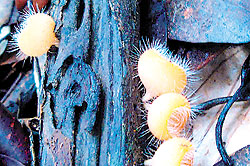
The trees' cabbage-like crowns are covered with leaves and provide fruits for some periods of the year.
Whether it takes half an hour or longer to cross, the canopy walkway is a must for anyone who ventures into the park. It consists of a steel structure with stairs, safely fenced in with netting and held by stout cables. This steel structure rises some 50 metres above the forest floor to the level of the highest trees.
The view in all directions is awesome and there's even a chance to see squirrels, monkeys, birds, lizards and a myriad of colourful insects and butterflies.
Trail hiking is the perfect means for nature lovers to indulge in their passion and the Ashton Trail at KBFSC, provides an exhilarating close experience with nature.
The ascent is not difficult in climbing terms but is strenuous for those who are not fit. Hikers must keep a lookout for leeches, especially after a downpour.
However, these hindrances are soon forgotten as one steps into this enchanting world of pristine serenity.
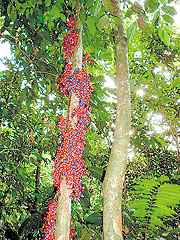
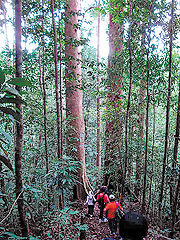
The trail promises a truly enjoyable hike with many new discoveries: numerous fungi, insects and animal species.
In the interior, visitors get to see a misty mixed dipterocarp forest thriving with Meranti, Shorea and Kapur trees.
Many of the largest trees have buttress roots which provide support for their massive trunks that can reach 40 metres in height before branching out.
Climbers (lianas) are common, their twisted trunks winding their way from the ground to the top of the highest trees.
Wonders of Belalong Rainforest
The Borneo Bulletin 18/10/2009
By NYL



Fifteen Physics lecturers and students of UBD got a taste of nature over the weekend when they totally immersed themselves in a Belalong rainforest experience in Temburong.
The excursion included a stay at Universiti Brunei Darussalam Kuala Belalong Field Studies Centre (KBFSC) in Batu Apoi Forest Reserve and a visit to the Ulu Temburong National Park.
It gave the visitors ample opportunity to gain knowledge about the natural environment and a deeper understanding of the ecology of the Belalong rainforest.
The National Park tropical rainforest is one of the most complex and rich ecosystems in the world.
This lowland dipterocarp forest thrives with its diversified fauna and flora, becoming a rich heritage of great interest for ecologist and nature enthusiasts alike.
Plant life is everywhere, but given the absence of sunlight, flowers are scarce. The highest density of flowers is nearer to the canopy.
To capture some of the elusive light, the giant trees, whose height can range to almost 100 metres, extend their smooth and circular trunks straight up to around 40 metres high before spreading their branches.



The trees' cabbage-like crowns are covered with leaves and provide fruits for some periods of the year.
Whether it takes half an hour or longer to cross, the canopy walkway is a must for anyone who ventures into the park. It consists of a steel structure with stairs, safely fenced in with netting and held by stout cables. This steel structure rises some 50 metres above the forest floor to the level of the highest trees.
The view in all directions is awesome and there's even a chance to see squirrels, monkeys, birds, lizards and a myriad of colourful insects and butterflies.
Trail hiking is the perfect means for nature lovers to indulge in their passion and the Ashton Trail at KBFSC, provides an exhilarating close experience with nature.
The ascent is not difficult in climbing terms but is strenuous for those who are not fit. Hikers must keep a lookout for leeches, especially after a downpour.
However, these hindrances are soon forgotten as one steps into this enchanting world of pristine serenity.


The trail promises a truly enjoyable hike with many new discoveries: numerous fungi, insects and animal species.
In the interior, visitors get to see a misty mixed dipterocarp forest thriving with Meranti, Shorea and Kapur trees.
Many of the largest trees have buttress roots which provide support for their massive trunks that can reach 40 metres in height before branching out.
Climbers (lianas) are common, their twisted trunks winding their way from the ground to the top of the highest trees.
No comments:
Post a Comment